To mark the 200th anniversary of Jane Austen’s death, the non-profit company  Destination Basingstoke commissioned artists to design Austen-themed, book-shaped benches that would be placed in and around Basingstoke, England, during the summer of 2017 and sold at auction in September to raise money for charity. Over twenty artists, many of them local to the area, contributed to designing and painting twenty-four book benches, and companies in the Basingstoke and Deane Borough sponsored twenty-two of the benches. The public art trail, appropriately named Sitting with Jane, was a part of the Hampshire Culture Trust’s “Jane Austen 200—A Life in Hampshire,” a year-long series filled with exhibitions, walks, talks, and performances devoted to honoring the writer.
Destination Basingstoke commissioned artists to design Austen-themed, book-shaped benches that would be placed in and around Basingstoke, England, during the summer of 2017 and sold at auction in September to raise money for charity. Over twenty artists, many of them local to the area, contributed to designing and painting twenty-four book benches, and companies in the Basingstoke and Deane Borough sponsored twenty-two of the benches. The public art trail, appropriately named Sitting with Jane, was a part of the Hampshire Culture Trust’s “Jane Austen 200—A Life in Hampshire,” a year-long series filled with exhibitions, walks, talks, and performances devoted to honoring the writer.
Although Sitting with Jane is not the first book bench series to appear in England, it is unique in how it artistically captured the joys of reading Austen’s works and temporarily reshaped the Austen tourist landscape. While walls enclosed most bicentennial exhibits, the Sitting with Jane trail invited people to go outside, travel in Austen’s footsteps, and experientially engage with public art. Itself a sign of tactile tourism, the trail summoned fans to approach Austen in a new way by sitting on the open pages of Austen-themed books while visiting well known literary shrines, such as Chawton Cottage, Winchester Cathedral, and lesser known Austen-related sites in the Basingstoke area. Further, trail visitors were encouraged to take pictures of themselves with the benches and share those images on social media. In a way, Sitting with Jane visitors were participating in “the transformation of a site into a tourist sight, something to be seen, witnessed, and possibly recorded” (Crang, “Placing” 118). Unlike most exhibits, which prohibit photography and any tactile treatment of their artifacts, Sitting with Jane epitomized a unique touristic “form of active engagement with Austen’s world”—one built on what Juliette Wells might deem “a very personal, and often physical, appreciation of Austen” (103).
Undeniably, Sitting with Jane provided fans with a new sense of “Austen places” and a new kind of literary tour. The benches fulfill two of the three criteria for what Wells calls “Austen places”: 1) “places in which she lived and (to a lesser degree) those she visited” and 2) a kind of place not explicitly tied to the writer, but one that “functions in a different way to focus visitors’ attention on Austen and her cultural significance” (111).1 After all, benches were located outside places Austen lived and visited, and in places that call attention to Austen’s cultural significance. Rather than asking fans to visit Austen houses, centers, or galleries to learn more about Austen, the trail functioned as a self-guided literary tour that united “author,” “reader,” and “tourists across time as well as geographically” (Spooner 43). Moving from the pages of Austen’s novels to the open bench seats, Sitting with Jane exemplified a key element of literary tourism: “the practice of visiting places associated with particular books in order to savour text, place and their interrelations” (Watson 1). In this particular example, the trail’s visited places were associated with Austen and particular books, such as Pride and Prejudice, and the benches were formed emblematically in the shape of books to symbolize the connection between author, reader, and tourist. Sitting with Jane, then, allowed visitors, most of whom were surely Austen readers, to experience the interrelation of the trail’s simulacra with Austen’s texts, and twenty-first-century signifiers of nineteenth-century signifieds. If, as Emma Spooner argues, the literary tour is “like reading a novel since the site itself functions as a narrative to be consumed,” then Sitting with Jane represents an Austen compendium replete with images of the past through the Regency era, of the present through women’s empowerment, and of the future through a beloved author’s abiding national legacy.
Ultimately, as the benches literally and metaphorically invited Austen visitors into the folds of their pages, the books provided fans with twenty-four chapters of a bicentennial Austen narrative. This paper will explore how the Sitting with Jane trail provided viewers with vignettes of Austen not only as an author but also as a biographical subject whose story is continually open to interpretation and is the subject of fans’ imagination. If, as Mark Crang notes, Austen “is made present through a range of commemorative symbols, sites, and, indeed, shrines,” then Sitting with Jane’s benches act as all three to commemorate Austen in this bicentennial death year and to explore what she continues to mean to her fans and the communities that claim Jane as one of their own (“Placing” 124).
Bringing Fans to Basingstoke and Reclaiming Austen
Besides honoring Austen in the bicentenary, Siting with Jane aimed to claim Basingstoke and Deane as Austen’s home and to bring tourists to the area. The art trail situated Basingstoke as an important point on the Austen tourist map, with each bench functioning as a kind of pin or historical marker for a place Austen either frequented or to which she had some connection. The twenty-four benches were purposely placed in sites in which Austen lived and visited to highlight her relationship with these places. While fans could venture to Steventon, Chawton, and Winchester to find a book bench, the majority of the benches were located in spaces likely lesser known to Austen aficionados, such as parks, gardens, museums, stores, and even a hotel in the Basingstoke area. Each site told a story about Austen and the location, thus commemorating one of the world’s most famous authors as a “local girl.”
Sitting with Jane promoted “the reflexive relationship between those who develop and present sites and those who visit and consume them” (Herbert 313). As a twenty-first-century update of the literary pilgrimage, Sitting with Jane presented Austen admirers a thrilling geocaching experience that allowed them to digitally track down Austen art objects. Fans could download from the Sitting with Jane website a PDF map or use the Sitting with Jane smart phone app to find the twenty-four benches in the Basingstoke area, and beyond.

Sitting with Jane PDF Map
(Click here to see a larger version.)

Sitting with Jane App
(Click here to see a larger version.)
Then visitors could hunt for each bench, thus fulfilling an important tenet of tourism: “an accumulatory economy in which sites are ‘done’ and ‘ticked off”’ as a way of “authenticating” the tourist experience (Crang, “Placing” 119). At each location viewers would find a plaque providing the bench name, artist, sponsor, and a brief explanation of the bench’s inspiration or intended meaning as well as the relationship between Austen and the site. The plaque-and-bench combination shows, as Crang puts it, “how Austen’s work is appropriated and circulated to produce senses of ‘hereness,’ which inscribe identities into places” (“Placing” 112). Just as “tourism is seen as a semiotic system that writes significance onto the landscape through markers,” such as plaques, on the Sitting with Jane trail “sites that would be unnoticed” in the Austen landscape “are brought to notice by being marked out” (Crang, “Placing” 118). As newly identified “literary locations,” these sites function as “simultaneously a repository for historical authenticity and a series of imaginative representations of places or things” (Spooner 42). Spaces such as courtyards and fields simultaneously represented places with authenticated ties to Austen and things (the benches) through which visitors could imagine Austen anew. As such, Sitting with Jane might be considered “primarily a journey of the imagination ignited by the physical locations and objects associated with Austen’s world and the world of her novels” (Spooner 49). In adapting the notion of traditional Austen literary tours, which typically “comprise visits to and the reading of scenes from novels in particular locations,” each Sitting with Jane’s “individual site becomes part of a larger itinerary binding [visits and readings of Austen] together in a spatial story” (Crang, “Placing” 117). This spatial story represents Austen’s novels, life, and geographical history.
Indeed, Sitting with Jane is as much about Basingstoke as it is about Austen. From its outset, Sitting with Jane focused on “Jane Austen’s heritage in north Hampshire.” The Sitting with Jane website and YouTube interviews with artists and sponsors reiterate that benches were placed in spaces visited by “Jane,” Basingstoke’s own “local girl.” Yet, the art trail intended not only to highlight Austen’s relationship with Hampshire but also to “reclaim Jane,” as Portsmouth Estates sponsor Viscount Lymington proclaims (“Viscount”). It seems that “Bath has stolen her” from Hampshire, and, as the De La Rue spokespersons argue, Basingstoke and Deane “need to steal her back again” (“Amanda”). Worting House sponsors, John Jervoise and Julie Kehoe-Smith, confirm such sentiments, saying that it was time to “bring [Austen] home” (“Worting”). All of these sponsors speak to what Austen scholars, such as Gill Ballinger, consider Bath’s “cultural appropriation of Jane” and “exploitation of Austen and her work” (Ballinger). Bath sites such as the Jane Austen Centre are byproducts of a thriving Austen tourist industry; this industry is exactly what Destination Basingstoke set out to capitalize upon when it devised the Sitting with Jane project.
Destination Basingstoke had the local economy in mind when it envisioned its plan to support the art trail. As Sitting with Jane’s website explains,
The idea for Sitting With Jane has been developed by Destination Basingstoke as a creative way to encourage visitors to explore in and around Basingstoke to enjoy everything the area has to offer from the superb countryside, great leisure and cultural offerings as well as to appreciate the wealth of local history and heritage and especially the area’s strong connection with Jane Austen.
It is clear that Destination Basingstoke and the Sitting with Jane bench sponsors envisioned the artworks as investments, collectively as a way to “put Basingstoke on the map,” according to Alan Gibson of the Basingstoke Deane Rotary Club (“Alan”). Long before the art trail was available to the public, the Sitting with Jane “About” page explained that other book bench projects rendered positive results, such as increased footfall, revenue, and charity donations, for communities involved. Sitting with Jane hoped to benefit from what David Herbert labels tourism’s “consumption segment”—“in which tourists form their attitudes and impressions that they may then transmit to others” (316). Sitting with Jane’s local success, therefore, depended not only on bringing tourists to Basingstoke and Deane but also on the impressions of the area they would share with others, which in turn might bring more visitors to the area. In a way, Sitting with Jane embodies “the effect of [an] imagined [Austen] landscape on the reshaping and marketing of the current landscape as a tourist product” (Crang, “Placing” 111). This claiming of Austen as a Basingstoke native is inherently tied to literary tourism in its “inventing, making, and remaking [of] places,” such as shopping centers and museums, in order to boost the local economy (Crang, “Cultural” 75).
Sitting with Jane aimed, however, not only to reinvent the Basingstoke area as an Austen repository. It also capitalized on Austen’s cultural cachet to raise money for charity. At the close of summer, the benches were removed from their sites and sold at auction in September, with seventy-five percent of the proceeds (approximately £100,000) going to the Ark Cancer Centre Charity. In this 200th anniversary of Austen’s death, one cannot help but appreciate that Sitting with Jane proceeds went to a charity dedicated to saving lives. Anticipating success earlier in the year, Merv Rees, Ark Cancer Centre Charity Trustee, stated that he had “no doubt” that the trail would “attract a great deal of attention locally, nationally and internationally”; further, he foresaw that “those involved in sponsoring and purchasing [the benches] will be contributing to a longer lasting legacy” (“Sitting with Jane Bookbenches”). Ideally, this legacy pertains both to cancer research and memorializing Austen’s life and works. Although the book bench trail has been dismantled, some of the benches will find their ways to public sites, such as museums. They will stand as a monument to Austen, the Sitting with Jane project, Basingstoke, and twenty-first century representations of Austen’s enduring influence on readers.
Sitting with Jane’s Austen Narrative
Although Sitting with Jane is not the first book bench series to appear in England, it is unique in how it artistically captured the joys of reading Austen’s works and temporarily reshaped the Austen tourist landscape. While walls enclosed most bicentennial exhibits, the Sitting with Jane trail invited people to go outside, travel in Austen’s footsteps, and experientially engage with public art. Itself a sign of tactile tourism, the trail summoned fans to approach Austen in a new way by sitting on the open pages of Austen-themed books while visiting well known literary shrines, such as Chawton Cottage, Winchester Cathedral, and lesser known Austen-related sites in the Basingstoke area. Further, trail visitors were encouraged to take pictures of themselves with the benches and share those images on social media. In a way, Sitting with Jane visitors were participating in “the transformation of a site into a tourist sight, something to be seen, witnessed, and possibly recorded” (Crang, “Placing” 118). Unlike most exhibits, which prohibit photography and any tactile treatment of their artifacts, Sitting with Jane epitomized a unique touristic “form of active engagement with Austen’s world”—one built on what Juliette Wells might deem “a very personal, and often physical, appreciation of Austen” (103).
In the summer of 2017, Sitting with Jane gave Austen enthusiasts twenty-four ways to reimagine the author and her works. The trail invited people to encounter Austen and her novels through serious and playful scenes, ranging from a pastoral homage to Steventon’s church to a comic book rendering of Austen’s female protagonists. The artistic homage was fashioned in a variety of styles and contexts. Some benches made use of naturalism and realism; others were inspired by fauvism, pop art, and comic books. While the naturalistic and realistic bench scenes venerated a conventional nineteenth-century view of Austen, the more modern styles interpreted her in daring ways that reflect on Austen’s relevance today, especially regarding women’s empowerment.
Sitting with Jane artists drew upon the ideas of romantic fantasy and personal liberty to give fans images of their beloved author and her books. The benches can be analyzed and understood in complementary categories—Austen as Regency author and as woman writer—which highlight two of aspects of Austen that fans love most.
Jane Austen, Regency Writer

Lois Cordelia's A Fine Day to Sit and Look upon Verdure (Front)
(Click here to see a larger version.)

Lois Cordelia's A Fine Day to Sit and Look upon Verdure (Back)
(Click here to see a larger version.)
Many book bench artists chose to represent Austen through nature, as evidenced by titles of works and their imagery. Two benches—A Fine Day to Sit and Look Upon Verdure and Look Upon Verdure—directly quote Mansfield Park. As Look upon Verdure artist Lois Cordelia explains, many benches asked viewers to “pause in our hectic modern lives, sit with [Austen] on a book bench, and rest our eyes on nature” (“Painting”). Both portray empty garden benches, thus inviting the viewer not only to sit on the actual bench but also to enter the naturalistic scene. Once Upon a Time in Steventon offers viewers a beautiful landscape depicting St. Nicholas Church and woodland creatures, thus placing Austen’s childhood grounds in a fairy tale setting. Chawton Woodwalk portrays a brightly arrayed tableau featuring two Regency-era women, assumed to be Jane and Cassandra Austen, walking among the trees and a quilt-like pattern of Austen words. These four benches link Austen to nature, thus immortalizing her as a kind of sylvan nymph who moved from the Hampshire trees to the pages of books.
Other benches, including Are You Sitting Comfortably?, The House that Jane Built, Regency Life, Willow Pattern, and Threads Lace & Time, move Austen indoors through hyper-realistic depictions of Regency artifacts, including a sofa, a dollhouse, a rug, china, and lace. Like the verdure benches, sitting is the subject of Are You Sitting Comfortably?, except this time the viewer is invited to sit on a bench showcasing a sofa in a beautiful Regency-era room. The book on the sofa is titled “Lady Susan’s Diary,” a nod to Austen’s early epistolary work.
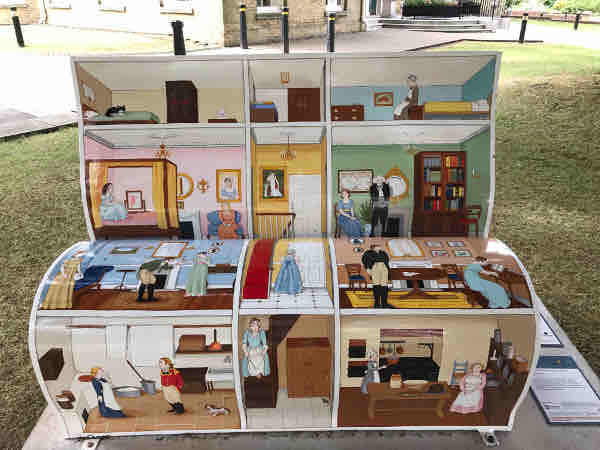
Jane Callan’s The House that Jane Built (Front)
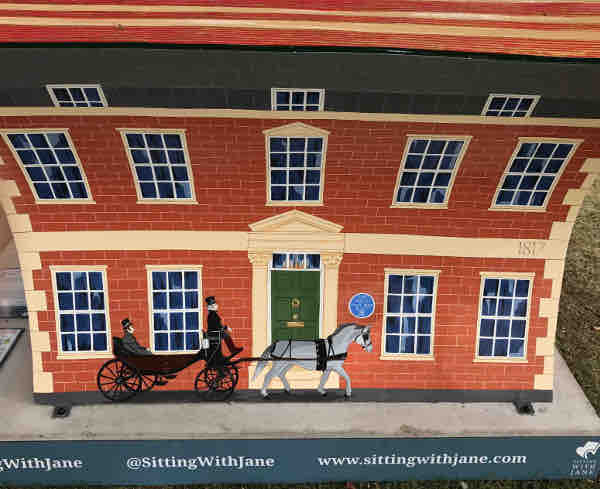
Jane Callan’s The House that Jane Built (Back)
The House that Jane Built gives viewers a peek into a Regency dollhouse that seems to double as a figurative house from one of Austen’s novels. The scene’s two middle panels depict two sisters alone in a bedroom in which the 1870 likeness of Jane Austen hangs, a young woman playing a piano, and a man courting a young woman. One gets the sense of the Bennet and Dashwood sisters in looking at this bench, as well as the class divide in an elite Regency home, as indicated by the final two panels’ illustrations of servants’ spaces. The final three benches mentioned above provide viewers with a closer view of the items that might be found in such a house—a rug, china, and lace. Willow Pattern in particular is noteworthy for its connection to the Austen family. The popular blue and white china pattern is combined with quotations from Austen’s writings, thus blending the visual with the verbal; the plaque accompanying the bench explains that fragments of this china pattern were found in the excavation of the Austens’ Steventon house. Here we find one of the many benches that appropriates Regency materiality to represent a romantic view of Austen’s life.
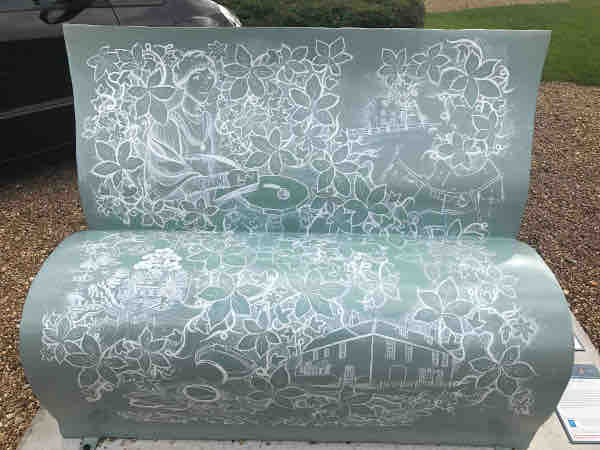
Corinne Marsh’s Threads Lace & Time (Front)
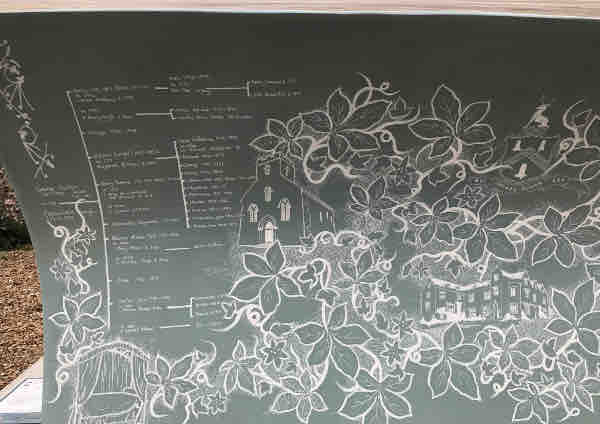
Corinne Marsh’s Threads Lace & Time (Back)
(Click here to see a larger version.)
Threads Lace & Time does the finest job of drawing on Regency material culture to blend a literal and metaphorical biographical narrative. As the bench title implies, the artwork uses lace threads to depict Austen’s life story and to tie together strands of time. Like Regency Life, which provides a timeline of Austen’s publication history, Threads Lace & Time weaves together images from Regency material culture, nature, portraiture, and biographical accounts in its holistic interpretation of Austen’s life. This bench embeds into its ivy lace pattern characteristic Austen places, such as Chawton Cottage and Chawton Great House, and Austen objects, including her canopy bed, turquoise ring, and topaz cross, to provide viewers with a biographical Austen tableau. Threads Lace & Time further includes an Austen family timeline, thus making explicit the importance of the familial connection. Surprisingly, of all the images of the author available to the artist, she chose the Byrne Portrait to represent Austen rather than either of the two Cassandra drawings.2 Perhaps the artist chose this portrait because it depicts a woman writing—a thread that other benches include. This bench seems to allude to other benches on the trail in its portrayal of the willow pattern, St. Nicholas Church, and the verdure so prominent in the nature-based benches. It effectively represents not only Austen as a biographical subject but also the Sitting with Jane art trail—intertwining historically inspired images of and references to Austen’s life and works to present what Gill Ballinger calls “a nostalgic perception of Regency England that makes Jane safe.” This fantastical cultural narrative, though, is only a part of what fans love about Austen.

Sian Storey’s The Golden Peacock (Front) (© Destination Basingstoke)
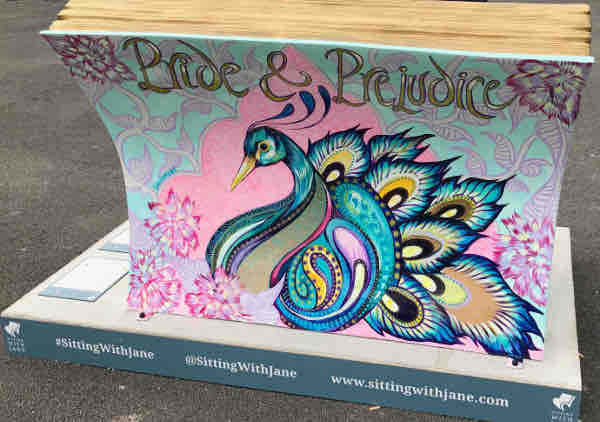
Sian Storey’s The Golden Peacock (Back)
Another prominent way that bench artists appealed to fans was through images related to her novels and characters. While benches cite or allude to all of Austen’s novels (as well as Lady Susan), references to Pride and Prejudice appeared on the trail more than other Austen works. Through direct quotations, visual renderings of Elizabeth Bennet and Mr. Darcy (even of Pemberley), and references to Hugh Thomson illustrations, viewers encountered Austen’s popular work in benches such as Jane Austen and Her Forgotten Peers, Waiting for Mr Darcy, Do You Dance Mr Darcy?, and The Golden Peacock. To connect with viewers, these benches bring to mind twentieth- and twenty-first-century Pride and Prejudice cinematic fandom, especially in their evocations of Mr. Darcy as the “perfect man” and the novel as a treasure trove of romantic Regency pastimes, such as country dancing. As David Herbert reminds us, “literary places,” in this case the trail’s many Regency-inspired benches, serve as “vehicles for . . . pleasure” (325). Readers love Austen’s Regency world, so the benches become contemporary extensions of that domain and act as Regency objects come to life.
Jane Austen, Woman Writer
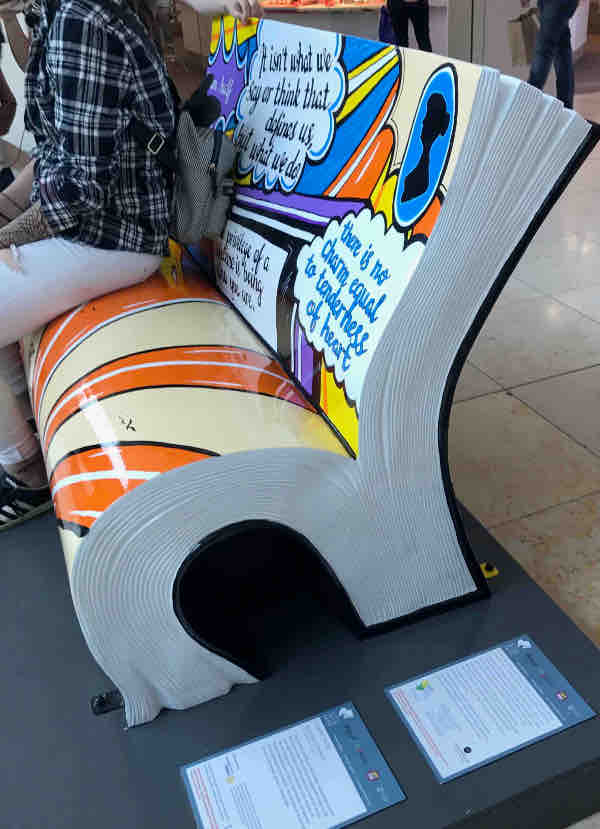
Jenny Leonard’s Jane Talk (Front)
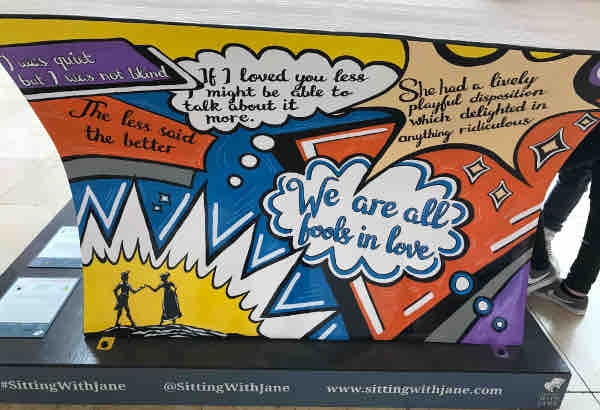
Jenny Leonard’s Jane Talk (Back)
Although the benches mentioned thus far situate Austen in an eighteenth- or a nineteenth-century context, others move beyond this time frame, presenting a fresh view of Austen as a symbol of the present age. One modern interpretation of Austen’s writing, Jane Talk, draws on pop art word bubbles and speech tags to capture Austen’s witticisms. The phrases resemble sound bites or quotations so popularly sought out by contemporary internet users.
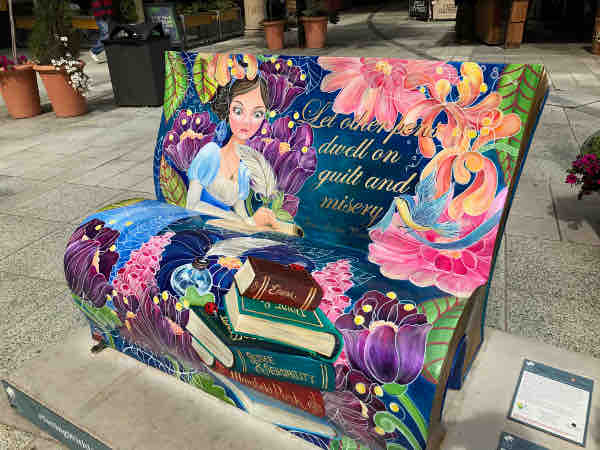
Katy Steven’s Beyond the Birdcage (Front)
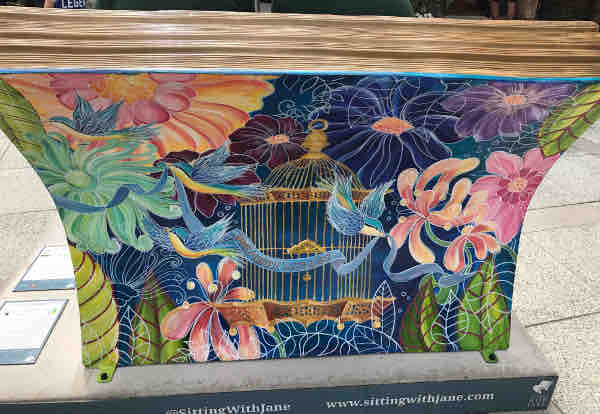
Katy Steven’s Beyond the Birdcage (Back)
Like Jane Talk, the benches Jane and Her Forgotten Peers, Beyond the Birdcage, Female Power, and Girl Power rely on eye-popping designs to situate Austen as a powerful woman writer. The first two of these benches approach the struggles faced by women writers,3 while Beyond the Birdcage likens women writers to songstresses and uses the symbol of the birdcage to show how voices (i.e., their writings) have been suppressed. The bench shows a young, brown-haired woman in blue—perhaps a modern update of Cassandra’s watercolor of a blue-bonneted Austen—writing in a book (presumably Northanger Abbey) with a quill pen. Austen’s five other novels appear stacked in the foreground. The plaque explains that the bench “represents the restrictions felt by women of Jane Austen’s time with the birds flying to symbolise the beginning of a new freedom inspired by Austen for women to begin to make their own choices in life, both emotionally and financially.” This theme of women’s agency becomes a trope among a handful of the Sitting with Jane benches.
One of the most stimulating aspects of the Sitting with Jane tour comes in its renderings of Austen as a woman writer whose nineteenth-century experience speaks to twenty-first-century readers, particularly women. As Wells notes, “The identity of Austen as a woman author matters greatly to tourists today, as we have seen . . . from visitors’ comments about how inspirational they find her as a woman, or how they value her perspective as a woman” (107). Spooner, too, recognizes that “female travellers may name Austen’s contribution to feminism, rather than her Englishness, as a defining feature of ‘The Austen Story’ because it is female independence which is important to them. Thus, literary sites”—in this case the Sitting with Jane benches—“act as a conduit for imaginative connections between the shifting cultural and historical groups to which Austen belongs and definitions of self” (47). Spooner argues that for fans the result of a “literary pilgrimage,” such as Sitting with Jane, has the potential “to bring them closer to understanding the woman, her writing, and perhaps themselves” (49). This theme continually appears on the trail.
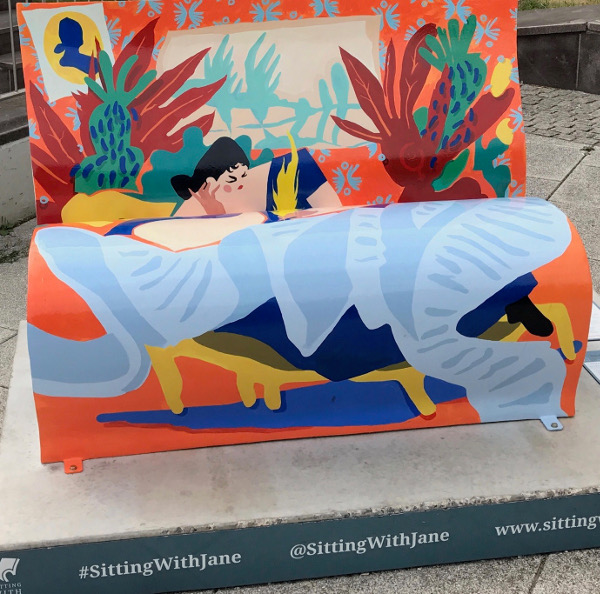
Fatima Pantoja’s Female Power (Front)
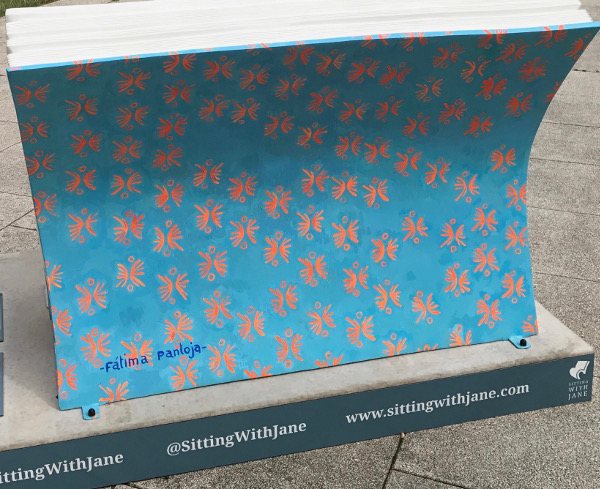
Fatima Pantoja’s Female Power (Back)
In a vein similar to Beyond the Birdcage, Female Power’s Matisse-like, brightly dressed woman sits writing a trail of pages. Although viewers will not likely see this black-haired, broad-shouldered woman as Austen, the plaque says that the “colourful BookBench depicts Jane Austen working at her desk—never ending paper and colours that reflect her strength and the vibrancy of her ideas.” The plaque also clarifies the bench’s title and argument: for women, writing is power.
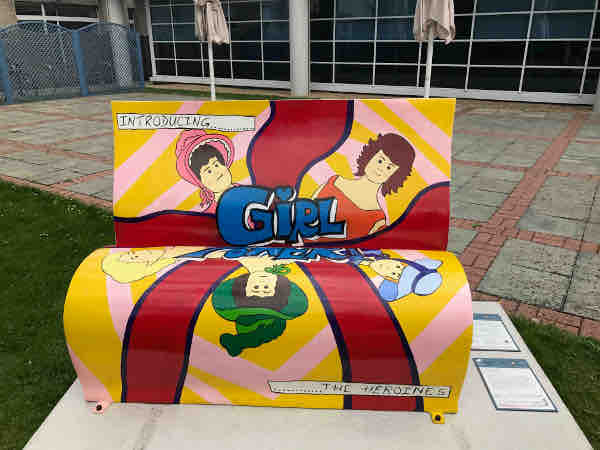
David Graham’s Girl Power (Front)
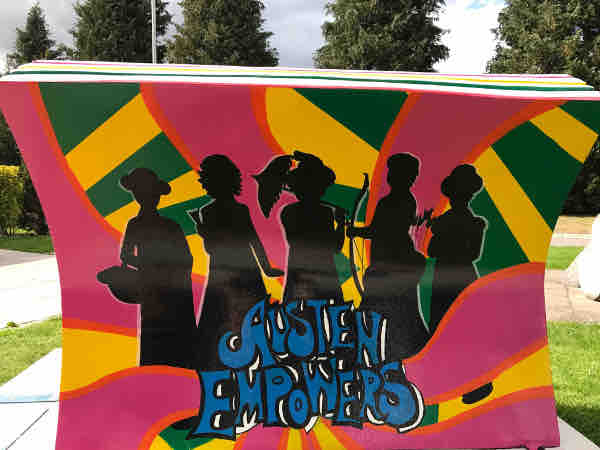
David Graham’s Girl Power (Back)
Likewise, Girl Power supports women’s agency, even though Austen herself is not the power player illustrated here. This bench takes a handful of Austen’s heroines and turns them into bonneted, mod action figures. The bench’s back situates them as “Austen Powers”—a play on the Austin Powers movie franchise, and perhaps a tribute to the romantic, strong-willed “James Bond” girls with whom Austin Powers collaborates to take down evil forces. This kitschy bench resembles fan fiction, for it takes Austen’s heroines from the pages of her books and gives them powerful new roles. Girl Power’s plaque reiterates not only Austen’s power as writer of such characters but also the power Austen gives to her readers: “Austen empowers women, and the bright colours of this BookBench and its comic book style are a fun way to celebrate Jane Austen’s super-heroines! A positive message of strength and vibrancy to emphasise the relevance of her work in today’s society.” Both benches’ paratexts repeat the phrase “strength and vibrancy,” making clear what women’s power means in this context. They communicate a potent message about Austen’s writing and its longevity. It is no coincidence that two benches featuring the word “power” depict Austen in a twentieth- and twenty-first-century artistic context, for Austen’s “strength and vibrancy” inspire readers today to emulate the fortitude and liveliness of Jane Austen and her heroines. Book benches such as Female Power and Beyond the Birdcage show a woman writer’s power to transcend her own time and continue to affect generations to come.
Sitting with Jane’s and Austen’s Legacy
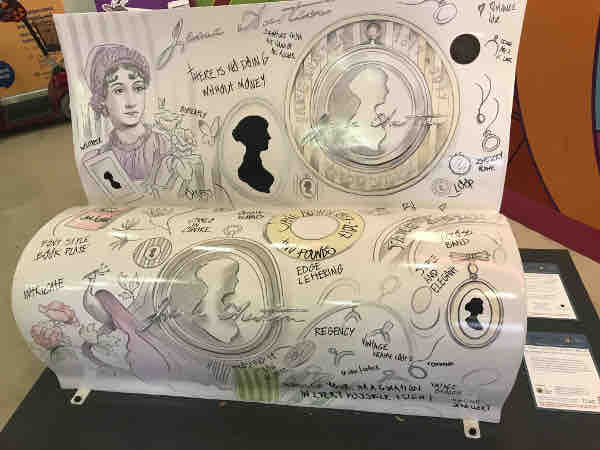
Dominique Evan’s There is No Doing Without Money (Front)
(Click here to see a larger version.)
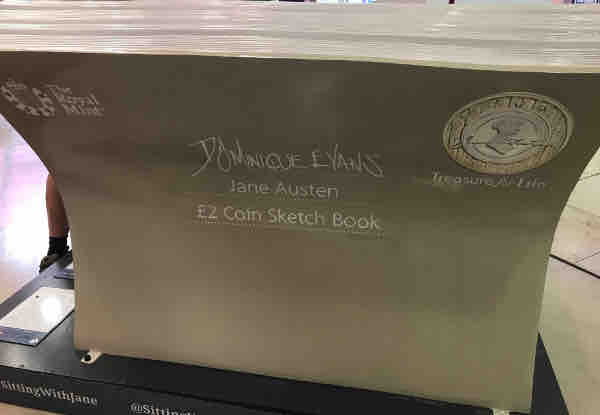
Dominique Evan’s There is No Doing Without Money (Back)
If we can imagine the Sitting with Jane benches representing the temporal categories of past, present, and future, the bench that best represents Austen’s past, her 2017 “currency,” and her literal future is There is No Doing without Money. Of all the benches on the Sitting with Jane trail, this one is certainly the most contemporary, even visionary, for it captures an artist’s work-in-progress as well as the recognition Austen has received in her placement on British currency. This bench includes details from Dominique Evans’s sketches for the Royal Mint’s new £2 coin. While Evans eventually decided that the famed Austen silhouette, Regency-era wallpaper, and Austen’s signature would be the design stamped on the coin, the bench shows many more sources of inspiration. Besides the actual sketches for the coin and even an embedded medallion replica, a version of the 1870 copy of Cassandra’s drawing of Jane appears on the bench, as do a peacock, a butterfly, and a series of descriptive words and phrases, including Northanger Abbey’s “there is no doing without money.” Like the recently released £10 banknote, which features a sentiment on reading uttered by Caroline Bingley, this bench’s title reads as ironic in its use of Isabella Thorpe’s crass commentary to hail Austen’s appearance on English money. Perhaps this irony speaks to Austen’s satirical style, as Bank of England Governor Mark Carney explained after delivering his July 18th speech at Winchester Cathedral introducing the new bank note. After all, one of the things fans love about Austen is how she critiques her characters to expose both their individual flaws and problematic societal norms.
Ultimately, There is No Doing without Money reflects the many reasons readers and fans adore Austen and her works, as well as the author’s contemporary circulation beyond her books and the Sitting with Jane book benches. As Austen’s face now graces two forms of currency, her image reminds fans and non-fans alike of her legacy as a woman writer who, “200 years after her death, . . . remains one of the best-loved authors in the world” and whose “novels were revolutionary in their treatment of subjects such as love, marriage and money” (Royal Mint). Like There is No Doing Without Money, each bench tells the story of Jane Austen, a vibrant early-nineteenth-century woman writer, whose work moves people two-hundred years later to pick up her novels, watch an adaptation, and even go on a treasure hunt to find twenty-four benches.
Sitting with Jane offered fans a unique “touristic moment” that connects not only with Austen’s past but also with her situation in our contemporary—even future—imagination (Troost 477). Even though the Sitting with Jane project has come to an end, the messages conveyed by this public art exhibit will persist as these benches find homes and people continue to interact with them. Each bench from Sitting with Jane will remain a testament to Austen’s legacy as a writer.
NOTES
1The other category Wells identifies is typified by museum space that “while holding no direct connections to Austen’s life, publicly displays objects once possessed by her” (111).
2The so-called Byrne Portrait, Cassandra’s drawings, and other possible images of Jane Austen are collected on the JASNA website (“Portraits”).
3For a full analysis of this bench, see Misty Krueger’s “Sitting with Jane and Her Forgotten Peers.”
